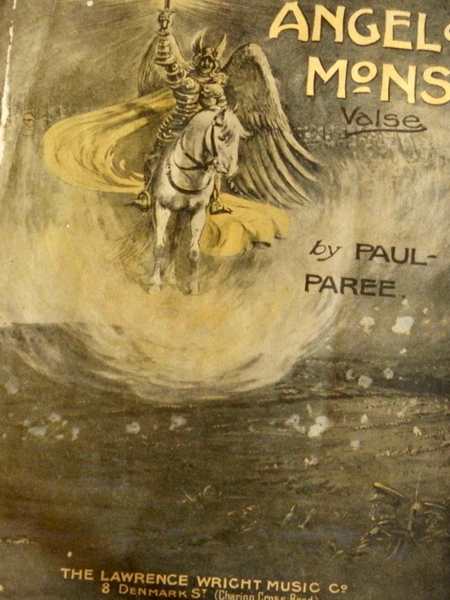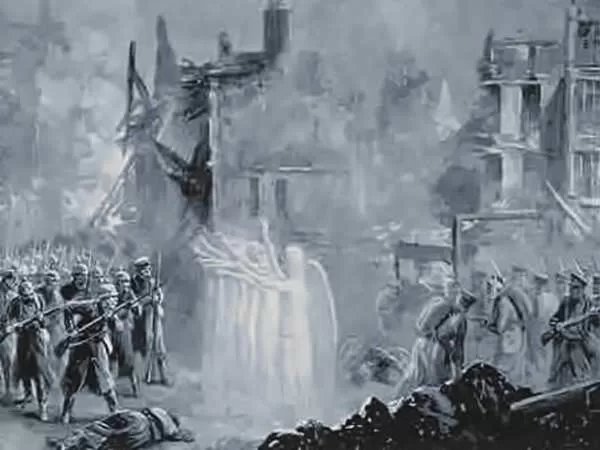August 1914 marked the beginning of World War I, a global conflict that forever altered the course of history. On August 4th, Britain declared war on Germany. By the 9th, the British Expeditionary Force (BEF) had arrived on the continent, tasked with defending the French left flank in what would become the first major engagement for British forces in the war. The BEF, though significantly smaller in number compared to their German counterparts, consisted of highly trained, professional soldiers. Their steadfastness at the Battle of Mons would not only frustrate German plans but also give rise to one of World War I’s most enduring myths—the story of the Angel of Mons.
The Battle of Mons: A Fierce First Engagement
By August 22nd, the BEF had dug in around Mons, Belgium, forming a defensive line along the Mons-Beaumont road and the Mons-Conde canal. These strategic positions were meant to protect the French Fifth Army from a German flanking maneuver after the Battle of Charleroi. The BEF’s commander, Field Marshal Sir John French, agreed to hold the position for 24 hours.
On August 23rd, the German First Army launched a fierce artillery bombardment on the BEF, aiming to exploit a weak point in the canal. The first substantial shots were fired by Drummer Edward Thomas, marking the official start of combat for British forces in the war. The German infantry advanced in close formation across four key bridges. However, the British troops were more than ready. Unlike the conscript armies of Germany and France, the BEF was composed of long-service volunteers trained in rapid-fire marksmanship. Each British soldier could reportedly hit a man-sized target 15 times a minute at a distance of 300 yards. This skill proved deadly for the advancing German soldiers, who suffered heavy casualties.
Despite these initial losses, the German forces adapted their tactics, attacking again in more open formation and broadening the front along the canal’s tree-lined banks. Although they faced fierce resistance, their sheer numbers began to overwhelm the British. By the afternoon, the BEF initiated a tactical withdrawal. Nevertheless, the Germans paid dearly for every inch of ground they gained. Despite suffering significant casualties themselves, the BEF’s defensive strategy frustrated the German plans for a swift and decisive victory in France.

The Great Retreat and Its Impact
The BEF’s retreat, often referred to as the “Great Retreat,” was a strategic withdrawal in good order. Even as they fell back, British forces managed to slow the German advance through a series of rearguard actions, buying valuable time for the French to regroup. Although the Germans had anticipated an easy victory against the supposedly weaker British force, they were left demoralized by the ferocity of the British defense. In contrast, British morale soared, inspiring a surge in recruitment back home. The BEF’s resistance at Mons had succeeded in delaying the German advance, ultimately preventing the swift invasion of France that the Germans had hoped for.
The Birth of a Legend: The Angel of Mons
While the Battle of Mons itself became a symbol of British tenacity, it was an urban myth that would further elevate the battle to legendary status. On September 29th, 1914, a short story titled The Bowmen, written by Arthur Machen, was published in The Evening News. The story described how, during the Battle of Mons, a British soldier called upon Saint George for aid, leading to the appearance of phantom archers from the Battle of Agincourt. These ghostly bowmen were said to have helped the British repel the Germans.
Despite Machen’s insistence that the story was purely fictional, the public began to accept it as a real account of divine intervention. The tale quickly spread and morphed over time. What began as a story of phantom bowmen soon became the legend of the Angel of Mons—an ethereal army of angels that had come to protect the British soldiers. Newspapers and other media outlets fueled the legend by publishing exaggerated stories of German atrocities, further cementing the narrative that the Allies were fighting a just and moral cause, blessed by divine forces.
The Angel of Mons in Popular Culture
The Angel of Mons legend found its way into popular culture, including music. One example is the Angel of Mons Valse, a waltz tune composed by Paul Paree. This piece of sheet music, which I’ve had framed on my wall for years, serves as a reminder of how quickly urban myths can take root and become accepted as truth. Despite thorough research, information on the Angel of Mons Valse remains scarce, a testament to how even historical curiosities can fade into obscurity over time.
Conclusion
The Battle of Mons was a defining moment in the early stages of World War I. Though heavily outnumbered, the BEF’s professionalism and courage under fire stunned the German forces, delaying their advance and raising British morale. Beyond its military significance, Mons also gave birth to one of the war’s most enduring legends: the Angel of Mons. This tale of divine intervention, though rooted in fiction, became a powerful symbol of hope and resilience in a time of unprecedented global conflict.

